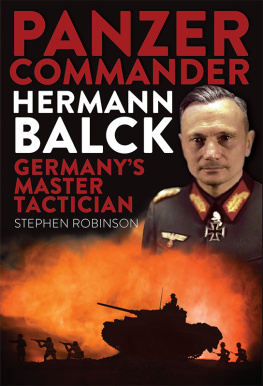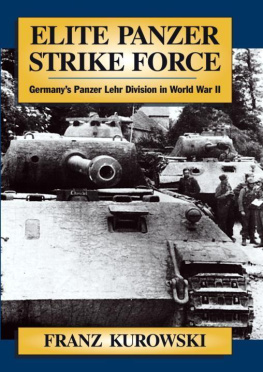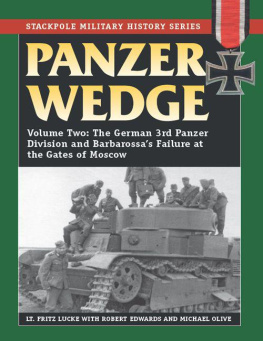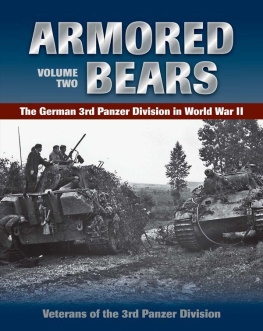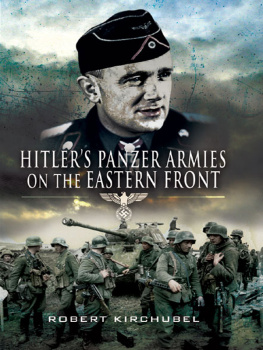PANZER OPERATIONS
PANZER
OPERATIONS |
GERMANYS PANZER GROUP 3
DURING THE INVASION
OF RUSSIA, 1941 |
HERMANN HOTH |
Translated by Linden Lyons |

|
CASEMATE
Philadelphia & Oxford |
Published in the United States of America and Great Britain in 2015 by
CASEMATE PUBLISHERS
908 Darby Road, Havertown, PA 19083
and
10 Hythe Bridge Street, Oxford, OX1 2EW
This English edition copyright 2015 by Casemate Publishers
Original German edition copyright 1956 by Scharnhorst
Buchkameradschaft GmbH
Originally published by Kurt Vowinckel Verlag, Heidelberg. This edition is published by arrangement with Druffel & Vowinckel Verlag.
ISBN 978-1-61200-269-9
Digital Edition: ISBN 978-1-61200-270-5
Cataloging-in-publication data is available from the Library of Congress and the British Library.
All rights reserved. No part of this book may be reproduced or transmitted in any form or by any means, electronic or mechanical including photocopying, recording or by any information storage and retrieval system, without permission from the Publisher in writing.
10 9 8 7 6 5 4 3 2 1
Printed and bound in the United States of America.
For a complete list of Casemate titles please contact:
CASEMATE PUBLISHERS (US)
E-mail:
CASEMATE PUBLISHERS (UK)
E-mail:

PHOTO CREDITS, BACK JACKET
top: Bundesarchiv, Bild 101I-265-0047A-34, Photog: Moosdorf
bottom: Nik Cornish at www.Stavka.org.uk
CONTENTS

Destruction of the Enemy in the Border
Areas, 22 June1 July |
Dedicated to the memory of
General Walther von Hnersdorff
1941: Chief of the General Staff of Panzer Group 3
1943: killed in action as the commander of the 6th Panzer Division
PREFACE

T his book does not purport to be a definitive account of the military history of the Russian campaign, for there were too few documents of any value. Official information from the Russian side is unavailable. Unfortunately, surviving German war records remain inaccessible for private research. This work is based on a privately held copy of the Combat report of Panzer Group 3 in Russia, 10 February 1942, prepared in the field by the First General Staff Officer of Panzer Group 3, Major Carl Wagener. This report contains not only valuable map records from which the course of operations can be traced, but also details on the considerations of the staff of the panzer group. It lacks almost all of the intelligence reports on the enemy, the wording of the orders received and adopted by the panzer group, and the reports by the subordinate corps headquarters. These gaps could only be inadequately filled by some documents presented by the American prosecution during the High Command Trial in Nuremberg in 1948.
Nevertheless, there are two reasons for attempting a critical analysis of the operations of a German armoured formation at the beginning of the Russian campaign. First, it will be beneficial for future research on military science to understand the motives which guided the actions of Panzer Group 3. Second, some inaccuracies in previous publications are corrected. Above all, though, this work should serve an educational purpose. It aims to give practical examples of the operational use of armoured formations and thereby to contribute to the training of future tank commanders.
In the first few months of the Russian campaign, Panzer Group 3 was the middlemost of the three northern German panzer groups. At the beginning of the campaign all three panzer groups were the principal means for executing the operational plan of the High Command. It is therefore natural to regard the operations of Panzer Group 3 not in isolation but in the context of the overall operations. For this purpose there are several documents available which were prepared for the Nuremberg Trials. Some of this material is still unpublished and unevaluated. They shed new light on the difficulties confronted by the military leadership. Even so, no final conclusions from the perspective of military history can be expected, because these documents represent only a selection, not the whole. Nonetheless, they are valuable for instructional purposes.
Given the instructional focus of this book, the performance of the troops and of the outstanding commanders is understated. The author hopes that the attentive reader will recognise how all the efforts of the leadership would have failed without the selfless dedication of the German soldier in battle against an enemy and country so alien and hostile in nature.
The author is indebted to the Institute of International Law at the University of Gttingen, and especially to Dr. Seraphim, for help in finding documentary evidence. The author is also grateful to retired Generals Otto von Knobelsdorff, Carl Wagener, and Joachim von Schn-Angerer for the use of material in their possession which relates to their part in the operations. Likewise, thanks to the retired Generals Friedrich Fangohr () and Ernst von Leyser for the information they provided.
Hoth
Goslar, summer 1956
MAPS

I n view of the fact that Hermann Hoth describes the actions of Panzer Group 3 in detail in his text while referring readers to the specific corresponding maps, it has been decided to reproduce here the original postwar maps from his German edition.
At the end of the section the reader will find a list of place-names where the German spelling differs significantly from the English. In the meantime it may be useful to note that Heeres-Gr. Nord and Heeres-Gr. Mitte refer to Army Group North and Army Group Center, respectively. In regard to smaller units, taking the example on the lower half of Map 2, in the concentration around the city of Bialystok:
rd. 20 Schtz Div., 6 K.D., 2 Pz. Div, 6 mot Br.
translates to
approx. 20 Rifle (Infantry) Divisions, 6 Cavalry Divisions,
2 Tank Divisions, 6 Motorized Brigades
The German word Feind means enemy, or in this context, Soviet units. The word Eisenbahnen refers to railways. The map titles themselves are translated at the bottom of each page.
Linden Lyons

MAP 1: Overview

MAP 2: Position of Army Groups Centre and North before the Invasion

MAP 3: Advance by Panzer Group 3 on 22 June 1941 and movements until 24 June

Next page


